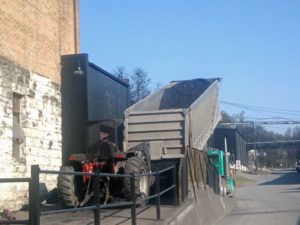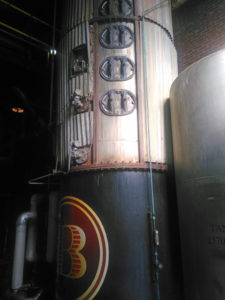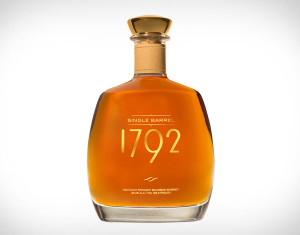By Richard Thomas

The distillery still heats its boilers with coal, much to the delight of Eastern Kentucky miners.
(Credit: Richard Thomas)
Whenever I consider what a tourist can expect from visiting a distillery, most fall into two broad categories. Some live up to the romantic notions of what a distillery should be, with wooden wash backs/fermenters, gleaming copper pot stills beautifully displayed, and barrels stacked in picturesque warehouses. Most, however, are whiskey-making factories, and they look like it too.
In between are a handful of distilleries that were built as factories, but because so little has changed there over the course of several decades, they have taken on a certain antique charm that belies their industrial functionality. These places are the antithesis of Erich Mendelsohn’s architectural modernism, because their supreme functionality in no way bends to conform to the asthetics of design, and over time such places gain charms both retro and rustic. The best example of this is the gloriously ramshackle Barton 1792.
Background
Barton’s claim to being the oldest operational distillery in Bardstown is based on it’s 1879 foundation, starting out as the Willett & Franke Distillery. Two distillers who had married into the Willett clain, Ben Mattingly and Tom Moore, were set up by the Willetts there, and the distillery became Mattingly & Moore. When that company was sold, Moore set up a new distillery on an adjacent property, and later bought back the original property, demolishing most of the original buildings.
This consolidated foundation under Moore is what evolved into today’s Barton 1792, and the natural springs on the property are named for him. Prohibition closed the distillery,which never acquired a license to produce medicinal whiskey. It reopened under Moore’s ownership in 1934, only to be sold to liquor baron Oscar Getz in 1944, who renamed it Barton. From there, Barton changed hands over the decades, coming into Sazerac’s ownership in 2009.
Retro And Rustic
Barton’s antique origins, its emergence from Prohibition intact, and it’s longstanding secondary role in whatever company owned it have combined to create a distillery that offers the most genuine throwback to what the industry was like before the bourbon bust of the 1970s.
An accident during World War Two, when industrial alcohol production was the priority, burned the old wooden still house down. The modern building dates from that time, while the still itself is a six-foot wide, five story tall, part-stainless steel, part-copper monster built by Vendome in the 1960s. It’s heated partly by natural gas boilers, but also partly by coal-fired boilers, using up to 50 tons of coal per day. The latter are an old fashioned oddity even in Japan and Scotland, nevermind in North America.
The plant is dotted with disused equipment and pipes, too expensive to remove. The control boxes look like they came straight from the 1950s, with modifications made over the intervening decades. So the 50 or 60 year old dials and switches might have a digital display from the 1980s plus a modern touchscreen.
Another rustic feature are the fermenters, built so part of the tanks are outdoors and part indoors. These bright silver cylinders are easily visible from the outside, and back in the day the design was quite efficient, since it dissipated some of the heat from fermentation into the cooler open air, saving on cooling costs. The only time this wouldn’t have worked was during the summer months, and Kentucky distilleries shut down for much the of the summer for maintenance anyway.
Visiting
Despite filling about 900 barrels a day, and producing the 1792 and Old Barton brands of bourbon, Barton 1792 is a remarkably crowd free destination. Whereas their sister distillery, Buffalo Trace, had 146,000 visitors last year, Barton had a mere 26,000. On an off-season weekday, you may find you are the only person taking the scheduled tour.
Against that, the tour of the still house involves lots of stairs, including one four story climb. It’s not particularly handicapped accessible, and even the merely unfit will find winding their way up the building demanding.
Three different tours, ranging from one hour to to two hours, are held Monday to Saturday from 9 am to 3 pm.
 The Whiskey Reviewer A World of Whiskey, Poured Every Weekday
The Whiskey Reviewer A World of Whiskey, Poured Every Weekday


